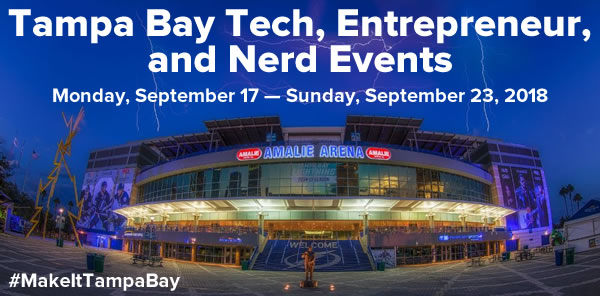
Every week, I compile a list of events for developers, technologists, tech entrepreneurs, and nerds in and around the Tampa Bay area. We’ve got a lot of events going on this week, and here they are!
Monday, October 8
- Tampa Bay Cyber Security Meetup — (ISC)² Security Congress @ Monday, 8:00 AM to Wednesday, 7:00 PM
- YouTube Support Group – Tampa @ Village Inn Restaurant (215 N Dale Mabry Hwy, near Kennedy), 5:00 PM to 6:00 PM
- Learn Cybersecurity Tampa — Cybersecurity Career Convos: Let’s talk about job security! w/ Mike Korman @ SecureSet, 5:30 PM to 7:30 PM
- Tampa Games Developer Guild — Monday Monthly: Understanding Game Performance in Unity @ AgileThought, Inc., 6:00 PM to 9:00 PM
- Wesley Chapel Speaks Toastmasters @ Nissan of Wesley Chapel, 6:30 PM to 9:30 PM
- Cool ‘n Confident Toastmasters @ SPC – St. Petersburg/Gibbs Campus, 6:30 PM to 8:00 PM
- Tampa Bay Thinkers — Let’s discuss the issues and players on the Florida ballot this November! @ Carrollwood Cultural Center, 7:00 PM to 9:00 PM
- Nerdbrew Trivia — Pints & Pixels Gaming Night! @ Brew Bus, 7:00 PM to 11:00 PM
- South Tampa Toastmasters @ Unity of Tampa, 7:00 PM to 8:15 PM
- Tampa Bay Bitcoin — Mining Mondays @ BlockSpaces, 7:00 PM to 9:00 PM
Tuesday, October 9
- Westshore Toastmasters @ FIVE Labs, 12:00 PM to 1:00 PM
- Snowflake Users Group – Talk Data Analytics Strategies with Airlines Reporting @ Jackson’s Bistro Bar & Sushi, 5:00 PM to 9:00 PM
- Weekly Open Make Night @ Tampa Hackerspace, 6:00 PM to 10:00 PM
- DTCC Tampa Technology — Fintech: Embracing Innovation to Maximize Value @ The Depository Trust and Clearing Corporation, 6:30 PM to 8:30 PM
- Tampa Artificial Intelligence Meetup — AI Study Group Meeting @ Town ‘N Country Regional Public Library, 6:30 PM to 8:30 PM
- Florida Podcasters Association General Meeting!!! @ IHop (4910 Spruce Street, Tampa), 6:30 PM to 8:30 PM
- Game Club Tampa Meetup — Tuesday Nite Roleplayers (RPGs) @ Grand Arena of Mind Expansion, 6:30 PM to 9:30 PM
- Code Katas — Let’s Do Some Fun Code Challenges! @ Suncoast Developers Guild, 7:00 PM to 10:00 PM
- Anime, Nerds & Geeks — AMC $5 MOVIES – VENOM! @ 7:00 PM to 9:30 PM
- St. Pete Beers ‘n Board Games Meetup for Young Adults @ Flying Boat Brewing Company, 7:00 PM to 10:00 PM
- Woodshop Safety (Members Only) @ Tampa Hackerspace, 7:15 PM to 9:15 PM
Wednesday, October 10
- Tampa Bay Cyber Security Meetup — Florida Cyber Conference @ Wednesday, 8:00 AM to Thursday, 6:00 PM
- 1 Million Cups St. Pete — AcroApp / i911 @ St. Petersburg Greenhouse, 9:00 AM
- 1 Million Cups Tampa — Dropzone Gunner / Ways Security – Companion Call for Help @ Entrepreneur Collaborative Center, 9:00 AM
- Open/FREE Coworking for Women Tech Entrepreneurs @ FirstWaVE Venture Center, 9:00 AM to 8:00 PM
- Tampa Bay GIS User Group — October Meeting @ FDOT District 7 Auditorium, 11:30 AM to 1:00 PM
- Tampa Bay Tech — Florida Cyber Conference 2018 @ Tampa Convention Center, Wednesday, 3:30 PM to Thursday, 5:00 PM
- Code for Tampa Bay Brigade — Open Hack Night @ Entrepreneur Collaborative Center (ECC), 5:30 PM to 7:30 PM
- Empowered Business Networkers of Tampa Bay — Open Networking: October @ Leo’s Italian Grill, 6:00 PM to 9:00 PM
- Tampa Bay Agile — Product Owner Group – Oct: Selling your Idea: Create a Compelling Elevator Pitch @ South University – Tampa, 6:00 PM to 8:00 PM
- Nerd Night Out — Beer and Board Game Night St. Pete @ Avid Brew Co., 6:00 PM to 10:00 PM
- Tampa Bay Data Science Group — TBDSG Standard Meeting @ Alessi/Vigo Foods Bacardi Memorial Tasting Room, 6:30 PM to 9:30 PM
- Learn to Code | Thinkful Tampa — Getting Started in Tech @ Secureset Academy, 6:30 PM to 8:00 PM
- Tampa Bay Inventors Council – www.tbic.us Weekly Meetup @ John F Germany Library, 7:00 PM to 10:00 PM
- Suncoast Developers Guild — Open Code @ Marble Side Building, 7:00 PM to 9:00 PM
- St. Pete Shopify 101 — Intro meeting and basic overview of Shopify @ 7:00 PM to 9:00 PM
- Introduction to Fusion 360 @ Tampa Hackerspace, 7:00 PM to 10:00 PM
- Cryptocurrency Tampa Meetup — Bitcoin/Cryptocurrency/Blockchain Meetup: News, Q&A, Networking, Social @ BlockSpaces, 7:00 PM to 9:00 PM
- Woodshop Tool Sign Off-Jointer, Planer, & Bandsaw (Members Only) @ Tampa Hackerspace, 7:00 PM to 9:30 PM
- The Suncoast Linux Users Group Meetup @ New HDR Location, 7:00 PM to 9:00 PM
- Suncoast Skeptics — Think + Drink at South Florida Museum @ South Florida Museum, 7:00 PM to 9:00 PM
- Nerdbrew Trivia — Games & Grog @ Peabody’s! @ Peabody’s Billiards and Games, 7:00 PM to 11:00 PM
- Carrollwood Toastmasters @ Jimmie B. Keel Regional Library, 7:00 PM to 8:30 PM
Thursday, October 11
- Big Data Developers in Tampa — IBM Community Day: Artificial Intelligence @ Online, 10:00 AM to 4:00 PM
- Zoho Tampa User Group — Tips and Tricks in Zoho CRM @ Marriott Westshore Hotel, 1:30 PM to 4:30 PM
- Game Club Tampa Meetup — D&D 5E (Looking for Players) — New Campaign @ Grand Arena of Mind Expansion, 5:30 PM to 10:00 PM
- Tampa Bay Azure User Group — Kubernetes on Azure from Kinect Consulting @ Microsoft Corporation, 6:00 PM to 8:00 PM
- Lean Beer for All Things Agile (St Petersburg) @ Pour Tap Room, 6:00 PM to 7:30 PM
- Game Drive — Game Drive’s Video Game Ironman Challenge Development @ John F. Germany Public Library, 6:00 PM to 9:00 PM
- Seffner D&D Meetup — 1st ed AD&D Campaign. Open to new players. @ 6:00 PM to 10:00 PM
- Front-End Design Meetup — React Native Up and Running @ Suncoast Developers Guild, 6:30 PM to 8:30 PM
- Tampa Bay Professionals (IT, Sales, HR & more) — FOR ALL PRO MANAGERS – The Performance Coaching Process: step by step @ WebEx Live-Online Session, 7:00 PM to 7:30 PM
- Clearwater/Dunedin Women’s Business Networking & Empowerment — Networking & Empowerment for Women @ RMT Construction, 7:00 PM to 8:30 PM
- IPA’s & API’s — Beta @ Dunedin Brewery, 7:00 PM to 10:00 PM
- Nerd Night Out — Thirsty Theater: Halloween (2018) & Halloween (1978)! @ Villagio Cinemas, 7:00 PM to 11:00 PM
Friday, October 12
- Lean Coffee for All Things Agile (Waters Location) @ Panera Bread (6001 W Waters Ave, Tampa), 7:30 AM to 8:30 AM
- Lean Coffee for All Things Agile (St Petersburg / Tyrone) @ Panera (2420 66th St North, St Petersburg), 7:30 AM to 8:30 AM
- Café con Tampa — All for Transportation: The Charter Amendment to Address Hillsborough’s Transportation Problems @ Oxford Exchange, 8:00 AM to 9:00 AM
- The Green Asterisk Coworking @ The Pearl, 9:00 AM to 5:00 PM
- Demo Day at Suncoast Developers Guild! @ Suncoast Developers Guild, 2:00 PM to 3:30 PM
- Entrepreneurs & Startups – Bradenton Networking & Education — Open House Anniversary 3 Year Party @ Station 2 Innovation Center, 4:00 PM to 7:00 PM
- Learn Cybersecurity Tampa — Beginner’s Intro to Capture The Flag @ SecureSet, 5:00 PM to 6:00 PM
- MARS ASTRONOMY CLUB — Dinner & Social before the M.A.R.S Meeting @ Perkins Restaurant (5002 E Fowler Ave, Tampa), 6:00 PM to 7:30 PM
- Learn Cybersecurity Tampa — Capture the Flag: Cybersecurity Hackathon @ SecureSet, 6:00 PM to 8:00 PM
- Game Club Tampa Meetup — New 5e Campaign – Heroes of Faerun (LFP) @ Grand Arena of Mind Expansion, 6:30 PM to 11:00 PM
- Geekocracy! — Strategy board game night and take-out from Cuban Breezes! @ Peral’s PC Repair, 7:00 PM to 11:00 PM
- MARS ASTRONOMY CLUB — M.A.R.S: Evidence for Planet Nine presented by Shirley Vuille from SPAC @ Perkins Restaurant (5002 E Fowler Ave, Tampa), 7:30 PM to 9:30 PM
Saturday, October 13
- Escape the Grind — Discover What’s Possible Empowerment Workshop @ Empower PT, 10:00 AM to 12:00 PM
- R Ladies Lab! @ The Entrepreneur Collaborative Center, 10:00 AM to 12:00 PM
- Christmas Ornament Craft Class #1 @ Tampa Hackerspace, 10:00 AM to 12:30 PM
- Geekocracy! — 2018 Tampa Oktoberfest Celebration! @ Curtis Hixon Waterfront Park, 12:00 PM to 10:00 PM
- Nerd Night Out — NNO Book Club: The Jemima Code @ Haveli Indian Kitchen, 1:00 PM to 3:00 PM
- Cyber-Jedi’s — Open Source Intelligence (OSINT) aka Information Gathering @ Cisco WebEx Webinar, 1:00 PM to 3:00 PM
- Christmas Ornament Craft Class #2 @ Tampa Hackerspace, 1:30 PM to 4:00 PM
- St. Pete Makers — Open Make Night / Open House @ St. Pete Makers, 6:00 PM to 8:00 PM
- Tampa Doctors & Masters — Tampa Octoberfest! @ 7:00 PM to 11:00 PM
- Portkey to Magic — Harry Potter and the Prisoner of Azkaban in Concert @ David A. Straz Jr. Center for the Performing Arts, 7:30 PM to 10:30 PM
Sunday, October 14
- Geekocracy! — Disc Golf at 22nd St. Park! @ 22nd St Park, 11:00 AM to 1:00 PM
- Tampa Drones Meetup — Open Fly Day – Come Fly With Us! @ Sheffield Disc Golf Park, 11:00 AM to 1:00 PM
- Permaculture Tampa Bay — Introduction to Permaculture @ Our Permaculture Farm, 1:00 PM to 4:00 PM
- Brandon Boardgamers — Sunday Game Development and Design @ Cool Stuff Games, 2:00 PM to 9:00 PM
- Geekocracy! — Play Dungeons & Dragons! @ 2:00 PM to 6:00 PM
- Nerd Night Out — Blazblue Big-Screen Tournament! @ Villagio Cinemas, 5:00 PM to 9:00 PM















